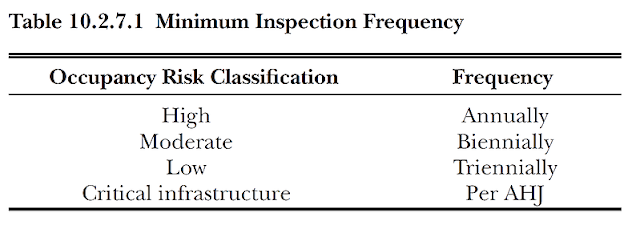Upcoming changes NFPA 1 in 2018 edition, minimum
fire prevention inspection frequencies for existing occupancies
Looking back, one part of the Code that
I don’t spend a lot of time talking about, but should, is how it is applied and
how it is enforced. Practically speaking, when does one even use a Fire
Code? Who needs to know how to enforce it? When is it enforced? How
often does the fire inspector, responsible for the enforcement of NFPA 1, need
to inspect a building for fire safety provisions? These administrative
requirements and general provisions, as contained in Chapter 1, Chapter 4 and
parts of Chapter 10, provide the fundamental provisions for those responsible
for its application and enforcement. Compliance with these requirements
is critical to the effectiveness of NFPA 1.
NFPA 1 is applicable to both new and existing occupancies. Per Section 10.1.1, every new and existing building or structure shall be constructed, arranged, equipped, maintained, and operated in accordance with this Code so as to provide a reasonable level of life safety, property protection, and public welfare from the actual and potential hazards created by fire, explosion, and other hazardous conditions. I highlight the words constructed and maintained to emphasize how the Code plays a role in a building during both construction of the building as well as maintenance throughout the life of the building. The enforcement of a building does not stop once its construction is complete and a certificate of occupancy is received.
NFPA 1 is applicable to both new and existing occupancies. Per Section 10.1.1, every new and existing building or structure shall be constructed, arranged, equipped, maintained, and operated in accordance with this Code so as to provide a reasonable level of life safety, property protection, and public welfare from the actual and potential hazards created by fire, explosion, and other hazardous conditions. I highlight the words constructed and maintained to emphasize how the Code plays a role in a building during both construction of the building as well as maintenance throughout the life of the building. The enforcement of a building does not stop once its construction is complete and a certificate of occupancy is received.
New to the 2018 edition is Section
10.2.7 which prescribes the minimum fire prevention inspection frequencies for
existing occupancies.
This Section was added, in part, to
recognize the publication of new NFPA 1730, Standard on Organization and
Deployment of Fire Prevention Inspection and Code Enforcement, Plan Review,
Investigation, and Public Education Operations, and in addition, to
provide guidance to AHJs and inspectors for ensuring existing occupancies
remain in compliance with the fire code. Section 10.2.7 reads as follows:
10.2.7 Minimum Fire Prevention Inspection
Frequencies for Existing Occupancies.
10.2.7.1 Fire prevention inspections shall
occur on existing premises in accordance with the minimum inspection frequency
schedule specified in Table 10.2.7.1. [1730: Table 6.7]
10.2.7.2 Where required or permitted by
the AHJ, the required fire prevention inspection shall be conducted by an
approved party that is qualified in accordance with NFPA 1031.
10.2.7.3 The AHJ shall be permitted to
approve alternative qualifications for the approved party specified in
10.2.7.2.
10.2.7.4 The provisions of 10.2.7 shall
not apply to detached one- and two-family dwellings or townhomes.
NFPA 1730 contains
minimum requirements relating to the organization and deployment of code
enforcement, plan review, fire investigation, and public education operations
to the public. The addition of new 10.2.7 incorporates the standard of
care, as specified in NFPA 1730, into NFPA 1. The default is that the local AHJ
should conduct the inspection. However, if staffing does not permit or if the
local jurisdiction does not have a qualified individual, the owner, occupant or
operator can retain an AHJ approved NFPA 1031 qualified individual to conduct
the inspection. Thereby, fire code compliance is achieved in accordance with
the 1730 standard.
The frequencies of the fire prevention
inspection are based on the occupancy risk classification. Table 10.2.7.1
includes four classifications: high, moderate, low and critical infrastructure
with frequencies ranging from annual to triennially or per the AHJ. What
is a high risk occupancy? What is critical infrastructure? The 2018 edition of
the Code also added the corresponding definitions from NFPA 1730 to Chapter 3
to assist with the application of the new table. For example, a low risk
occupancy is “an occupancy that has a history of low frequency of fires and
minimal potential for loss of life or economic loss. Examples of low-risk
occupancies are storage, mercantile, and business.
How does your jurisdiction manage fire
prevention inspections for existing buildings? Do you use the provisions
in NFPA 1730? What issues have you faced with existing building
inspection?

